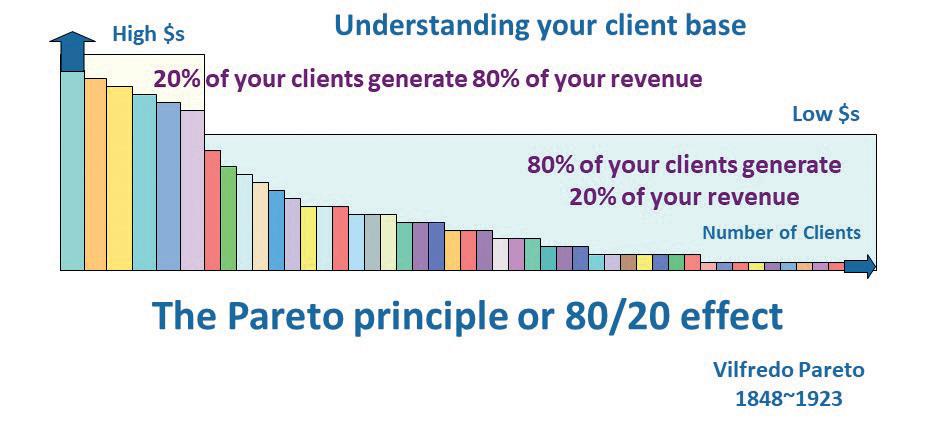
5 minute read
CHANGE THROUGH PERSUASIVE ACCEPTANCE
from Quarry May 2022
by Prime Group
CREATING CHANGE
THROUGH PERSUASIVE ACCEPTANCE
Drawing on the 80/20 principle, IQA Fellow and certified coach Mike Cameron highlights the necessity of focusing efforts strategically to achieve a greater level of acceptance using the persuasive acceptance method.
In September 2020, in an article I wrote for Quarry on developing key accounts, I suggested that their effective establishment and subsequent management are based upon establishing and maintaining a synergistic relationship with your customers, and appreciating the significance of the Pareto principle (which implies that 80 per cent of outcomes come from 20 per cent of causes) in evaluating the relevance of those relationships.
Dr Stephen R. Covey, writing in his book The Seven Habits of Highly Effective People, defined ‘synergy’ as “the principle of creative co-operation” and he stated that the development of an effective partnering relationship is dependent upon mutual respect, trust, openness, integrity, comparable cultures and values, and communication.
Therefore, the selection of sales professionals to develop effective key account plans is critical, as is the allocation of a particular type of sales territory to any given salesperson – and the choice should satisfy several criteria: • The territory should match the knowledge, skills and personality type of the salesperson involved. • It should provide a fair level of potential business so each salesperson is able to make a living, and to ensure that no territories go under-served. • It should be designed with reasonable travel demands or acceptable ease of access.
Taken together, it is obvious that whichever territory structure(s) you select you will need to cover your whole target market, or you may even need to reappraise your overall resourcing levels and review profitability
Even with a perfect territory design, however, each salesperson will still need to prioritise their activities by account.
As the Pareto principle often applies – 80 per cent of your revenue will come from 20 per cent of your clients – it is critical that salespeople do not waste their time on deals that will not deliver.
In October 2021, I was invited to make a presentation via Zoom on the process of implementing sustainable change, followed by an open discussion with a number of graduate students at a university in the US sate of Ohio.
Obviously, the Pareto principle will play its part; however, with the best will in the world it should be appreciated that your ideas will seldom be accepted unchallenged by everyone.
Frequently, there will be a small group (2.5 per cent) who actively support your ideas regardless, with another small group (five per cent) quickly adopting your view(s). I refer to these people as “followers”.
However, at the other end of the spectrum, there will always be a small group (2.5 per cent) who actively oppose your ideas regardless, followed by another small group (five per cent) quickly rejecting your view(s). I refer to these people as “naysayers”.
The process of implementing sustainable change (as shown in the bell curve diagram, above right) is as follows: 1. Engage with everyone as you present your vision/concept/change project. Discuss the need for the change and highlight the benefits. Continue to share your ideas with everyone until you feel that you have acceptance by around 42.5 per cent of the overall group, then move on to the second step. 2. Focus on the 15 per cent vocal undecided (which I refer to as “fence sitters”) and seek to understand their concerns. Look for opportunities to actively engage in discussion while applying effective listening skills. As you gain appreciation of their issues – perhaps requiring some adjustments to your original plan – you agree the way forward and openly communicate and (if required) confirm these negotiated changes with the overall group, thereby converting your “fence sitters” into “advocates”. 3. With the support of the “pro-change” people (35 per cent), your advocates and followers – 57.5 per cent in all – concentrate on communicating to and with this group of people as they help move the overall group to around 75–80 per cent in favour of the change.
Having received positive responses from the graduates, I posted the bell curve

diagram on LinkedIn, where It received almost a thousand views and comments. Here’s two examples:
“An interesting visual presentation attracting the followers, then focusing on the fence sitters to get majority acceptance from both advocates and followers to drive forward.”
My response: You can spend time and stress on trying to change opposition to your ideas without success. Life’s reality is few leaders have the support, or the opportunity, to enjoy the acceptance of more than 75–80 per cent of people within their area of influence. In my experience, it is more effective and less stressful to focus on winning the hearts of your ‘followers’ and ‘supporters’ who will, if encouraged, enable your message to become better understood/ accepted by “fence sitters” and less committed “naysayers”.
“Good representation and explanation, Mike. While I’ve never used the same terms or the figures you have here, I always use the same logic. There will always be those who agree/ follow and always a group that isn’t sure one way or the other. Your efforts need to be with those and to enlarge the size of that group. But no matter what you do there will always be some who are set against whatever is proposed and you have to deal with them appropriately.”
My response: I’m a fan of the Pareto principle (the 80/20 rule) and I think that it and the distribution curve concept have been clearly demonstrated, over the past few months, through our struggles to achieve vaccination targets.
If it meets your needs, feel free to try this form of persuasive acceptance if you are having difficulty with the change process. •
Innovation
is our Motivation...







